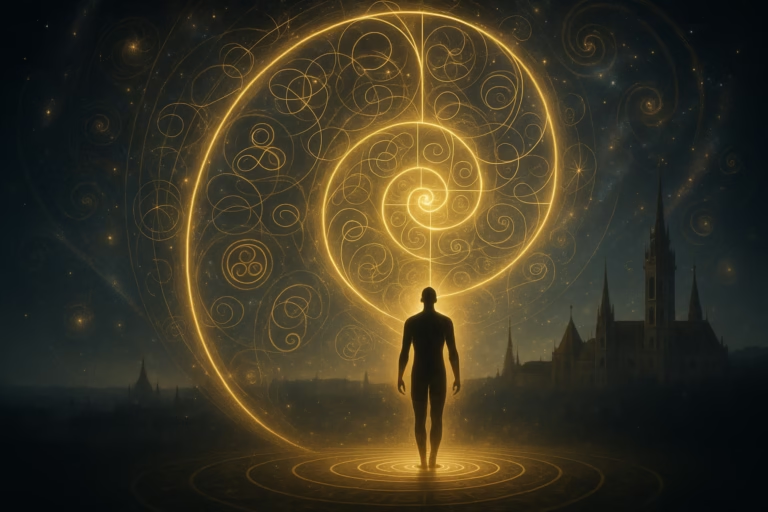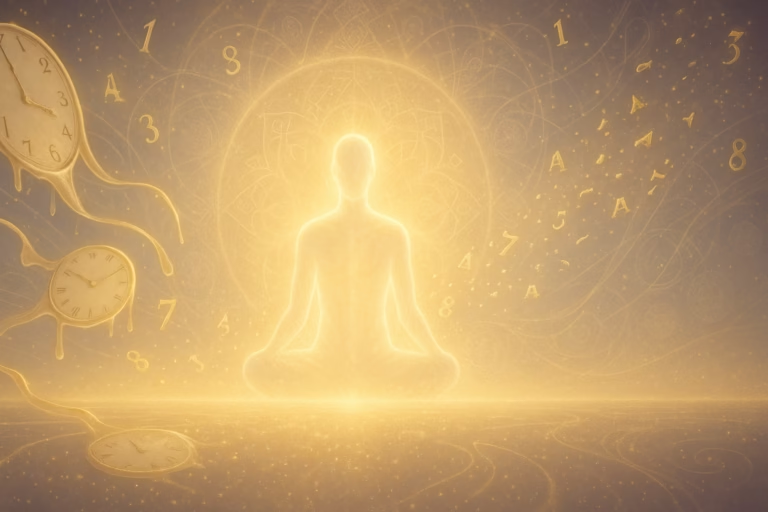PODCAST: Breaking the Status Trap
A Morning Commute and a Lingering Question
The day begins with a quiet, predictable ritual. As the city awakens, a commuter finds themselves scrolling through a digital feed, their attention captured by a colleague’s recent vacation, meticulously documented, or an influencer’s latest high-end purchase, perfectly framed against an exotic backdrop. This moment of observation triggers a subtle internal response: a flicker of envy, a whisper of inadequacy, a quiet question of why their own life feels, in that instant, less than. This seemingly innocuous moment is not just a passing thought; it is a narrative hook, a personal and introspective opening that invites the observer to recognize their own participation in a culture of comparison. This feeling is not new; it is a modern manifestation of an ancient conflict: the inner war. It is the first whisper of the seduction of power, the desire to achieve status through material symbols. This is the central paradox of a disconnected society: the feeling of “less than” drives an individual to seek “more,” not realizing that what they are chasing is a trap built on the very illusion of worth they are trying to attain.
I. The Architecture of Disconnection: Why We Build the Golden Cage
This modern culture of status symbols is not an accident. It is a carefully constructed system built on psychological drivers, economic forces, and the pervasive influence of technology. The very desire for a luxury good is a deeply rooted human phenomenon, a complex interplay of perceptions, behaviors, and social interactions that can be traced back to our evolutionary past. To understand how to break free from this trap, one must first understand the architecture of the cage itself.
The Mirage of Material Value
The luxury market over the last decade has been a study in contradictions. From 2019 to 2023, the industry for personal luxury goods saw “unprecedented demand” that drove a 5% compound annual growth rate. Brands, particularly those with revenues over €5 billion, leveraged their scale to increase visibility and desirability, with price hikes accounting for more than 80% of this growth. This period was defined by a rapid expansion that allowed luxury brands to achieve new profitability records, while outperforming global markets.
However, this aggressive growth has proven to be unsustainable. As of 2025, the luxury industry is facing a significant slowdown. Price increases have “reached a ceiling,” eroding the perception of value among consumers. Research shows that over 60% of luxury consumers are buying fewer items due to price increases, and more than half feel the quality no longer justifies the cost. This has created a growing divide in the market. While affluent and high-net-worth individuals maintain their ties to ultra-luxury brands, a new generation of “aspirational luxury enthusiasts” is being priced out of the market. These younger shoppers, who have the desire but lack the spending power, are a key segment for the future, as Gen Z and Millennials are expected to dominate the luxury market by 2030.
This economic data points to a deeper crisis: the facade of material value is starting to fracture. The market’s own mechanics of constant price increases and overexposure are weakening the promise of exclusivity and craftsmanship. Consumers are beginning to question if the core value proposition of luxury is still being met. This collective re-evaluation of value mirrors the initial “cracks beneath the surface” that Elias Chronis discovers in the Fractal narrative, where systemic anomalies begin to destabilize a world that once seemed solid. This moment of collective doubt is not a collapse, but an opening for a new understanding of what constitutes true worth.
The Psychology of the Persona
The desire for status symbols is not merely about owning beautiful objects; it is rooted in deep-seated psychological mechanisms. One of the primary drivers is the concept of social comparison, where individuals have an “innate tendency to compare themselves to others, seeking validation and a sense of self-worth”. Status symbols serve as “visible markers” that allow people to position themselves within a social hierarchy. This is a form of “conspicuous consumption,” a behavior driven by the desire for social recognition and admiration that signals one’s wealth and social standing. The psychologist Thorstein Veblen argued that this behavior is not about functional value, but about making a statement of affluence and exclusivity.
This phenomenon also has an evolutionary echo. From an evolutionary psychology perspective, the pursuit of status symbols taps into ancient drives for “social belonging” and, at a more primal level, “reproductive success”. In a consumer-driven society, these inclinations manifest as the endless quest for elevated status, where a high price point and brand recognition are used as psychological shortcuts for quality and desirability.
The Digital Mirror: Social Media as the Main Stage
In the modern era, social media has become the central stage for this display culture. A significant majority of luxury consumers—85%—use these platforms, and brands have responded by leveraging them for promotion and brand awareness. Celebrities and influencers play a crucial role, creating “aspirational contexts” that make luxury items seem essential to a successful life. The psychological impact of this is magnified by “parasocial relationships”—the one-sided emotional connections consumers form with celebrities. When a celebrity endorses a product, their followers perceive it as a recommendation from a “trusted friend” rather than a paid advertisement, which significantly increases its influence and purchase intention.
A fascinating paradox is emerging within this digital culture. While the traditional model of luxury was built on flaunting exclusivity, new strategies are being employed that cloak status-seeking in the language of authenticity. Brands like Moncler are using “storytelling” campaigns that highlight “dreamers” and “creatives” to add authenticity and connect with younger audiences, making the brand feel more like a community. This makes the trap of status even more insidious: the desire for external validation is now being packaged as a quest for inner worth, blurring the lines between a genuine search for meaning and the consumption of a carefully crafted narrative.
II. The Weight of Emptiness: The Hidden Costs of the Status Trap
The pursuit of status symbols, while seemingly harmless, comes with a profound and often unseen cost. This is the weight of emptiness, a spiritual poverty that results from living a life defined by external validation rather than internal worth. The philosophical framework of the Oracle provides a clear lens through which to understand this hidden price, connecting modern psychological traps to ancient spiritual vices.
The Spiritual Poverty of Vanity
The Oracle defines vanity not as a superficial flaw, but as “the obsession with how others see you” and “the belief that your worth is determined by the opinions of others”. This vice is a spiritual ailment because it traps an individual in a “cycle of needing to be more than you are”. The pursuit of external validation, whether through a luxury car or a high-profile social media presence, creates a reliance on external factors to define one’s self-worth. This makes an individual’s sense of value fragile and dependent on the ever-changing opinions of others. The core of this spiritual poverty is a disconnect from one’s authentic self, as a person is constantly performing a role or wearing a mask to gain approval.
The Illusion of Lack and the Vice of Greed
This vanity is deeply intertwined with the vice of greed. Greed is defined by the Oracle as “the endless chase for more” and “the hunger for what you already have”. This psychological paradox is supported by research on the “hedonic treadmill,” which shows that people quickly adapt to new possessions, causing the initial joy to fade and leading to a “cycle of wanting more or newer things to regain that fleeting happiness”. The article posits that greed is a direct result of the “illusion of lack” that external validation creates. A person who feels they are not enough seeks a symbol to fill that void. The temporary satisfaction from the purchase provides a fleeting dopamine hit, but the feeling quickly dissipates, leaving a deeper sense of emptiness and a renewed search for another symbol. This self-perpetuating cycle of wanting is a powerful metaphor for the “inner war” of the ego’s desire for control. The article demonstrates that the status trap is a closed loop of suffering, where the very act of seeking validation creates the very void it is meant to fill.
The Widening Fracture & Collective Disconnection
The costs of the status trap are not just personal; they are societal. The psychological mechanism of “social comparison” is the foundation of this culture, which inevitably leads to feelings of “envy and dissatisfaction”. When worth is a competitive game, it naturally widens the gap between people and breeds a sense of division. This is evident in the luxury market’s structure, where the motivations of affluent individuals, who buy for investment and pleasure, differ from those of “aspirational luxury enthusiasts” who seek a “confidence boost”. As the latter group gets priced out, the societal “fracture” deepens, creating a disconnected society where the quest for worth becomes a zero-sum game. The constant need to prove one’s value through external symbols erodes the foundational belief in inherent worth, creating a world where people are constantly measuring themselves against others, leading to a breakdown in genuine connection and empathy.
III. The Awakening Keys: A New Path to Inner Worth
The path out of the status trap is not one of denial or struggle, but of a profound shift in perspective. It is a journey from the pursuit of external symbols to the cultivation of inner worth, guided by the core virtues of humility and gratitude as presented by the Oracle. This awakening is not an escape from a comfortable life, but an intentional act of conscious creation that builds a stronger sense of self and community.
From Vanity to Humility
The antidote to vanity is humility, but not as it is traditionally understood. The Oracle defines humility not as “thinking less of yourself,” but as “the strength to acknowledge your limitations” and the “recognition that you are part of something far greater than your individual self”. This is a powerful, active choice to step out of the ego’s need for constant validation and into a state of deep, inner stability. Humility frees an individual from the “obsession with how others see you,” allowing them to live in alignment with their authentic self. It is the foundation of self-respect, a deep recognition that one is inherently worthy and that their dignity is not negotiable. This is the central paradox of the awakening path: only by surrendering the ego’s need for control and accepting one’s limitations can an individual achieve true alignment with the greater whole. This is the essence of Elias’s journey, where he must let go of his desire for mastery to achieve true clarity and freedom.
The Gift of Gratitude as a Gateway to Abundance
The direct counter to the vice of greed is the practice of gratitude. The Oracle presents gratitude not just as a feeling, but as “the gateway to abundance”. This practice counters the “illusion of lack” that drives greed by shifting an individual’s focus from what is missing to “what is already here”. This re-programs the mind from a state of constant craving to a state of peace and contentment. The more a person practices gratitude, the more they will see abundance in their life, and the more the world will reflect that abundance back to them. Practical methods for cultivating this virtue include keeping a gratitude journal, where one writes down things they are grateful for each day, and expressing appreciation to others through sincere gestures.
The Shift from “Having” to “Being”
The synthesis of these two virtues—humility and gratitude—is the core of the awakening path. It represents a fundamental shift from a life of “having” to a life of “being.” The Oracle’s teachings make it clear that “true wealth is found not in what you have, but in what you are”. This is not a denial of comfort or quality, but a re-direction of a person’s innate human drives for connection and self-definition. By embracing humility, one releases the need to possess and control, and by practicing gratitude, one finds peace in what is present. This is how a person becomes a conscious participant in the fractal, rather than a mere consumer of its projections.
Table 1: The Psychological Drivers of Status vs. The Path of Awakening
The Driver of Status | The Shadow (Vice) | The Path of Awakening (Virtue) |
|---|---|---|
Social Comparison | Envy & Division | Humility & Self-Acceptance |
Conspicuous Consumption | Greed & Vanity | Gratitude & Mindful Spending |
External Validation | Spiritual Poverty & Emptiness | Inner Worth & Presence |
IV. The Practice of Presence: A Blueprint for a New Life
Moving from the theoretical to the practical, the path of awakening requires a blueprint for daily living that replaces the habits of consumption with the rituals of presence. This section offers tangible, actionable guidance to help an individual live a life of inner worth, mirroring the practical wisdom found in the Oracle’s teachings.
Mindful Spending as Sacred Action
The first practical step is to transform the act of spending from a mindless transaction into a sacred action. Mindful spending is about “paying attention to where your money is going” and making spending decisions that align with one’s values and goals. This practice is a direct counter to the impulsive, often unconscious, nature of consumer culture.
Mindful spending can be implemented through simple, repeatable actions:
- Create a budget: This helps an individual understand their spending habits and identify areas where they can cut back to support their values.
- Track purchases: Using an app or a simple journal to track every purchase makes an individual more aware of their spending habits.
- Avoid impulse buying: A powerful practice is to wait 24 hours before making an impulse purchase. This pause allows for reflection and helps an individual determine if the purchase aligns with their values or is simply a response to a fleeting desire for external validation.
Mindful spending reclaims an individual’s power, turning a simple purchase into a conscious choice that reinforces their internal values rather than a surrender to external pressure.
Investing in Experiences, Not Just Things
Research consistently shows that investing in experiences leads to more enduring happiness and life satisfaction than purchasing material goods. This is because the satisfaction from possessions, known as the “hedonic treadmill,” fades as the novelty wears off. In contrast, experiences—whether a trip, a class, or a shared meal with friends—create “memories that can last a lifetime” and contribute to an individual’s “self-identity” in a more profound way.
A key benefit of this shift is the fostering of genuine connection. While material possessions can fuel social comparison and envy, experiences are unique to each individual and are more likely to create bonding moments through shared stories. Research from a 2024 study suggests that experiential purchases foster a greater “sense of connection to humanity” and a desire for more social activities than materialistic ones. This directly addresses the deep-seated psychological need for belonging and connection that the status trap attempts to fill with fragile, external symbols.
The Art of Service and Contribution
The final and most profound step on the awakening path is to shift one’s focus from personal accumulation to collective contribution. A life of inner worth is not found in what one possesses, but in how one serves. The pursuit of status is fundamentally self-centered, but the awakening path leads to the realization that an individual’s purpose is not about personal success but about “contributing to the greater whole”. The Oracle’s teachings and Elias’s journey present service as the ultimate antidote to the self-centered nature of vanity and greed, inviting a person to become a “gardener of truth” and a “protector of life”.
Table 2: Practical Antidotes: Shifting from “Having” to “Being”
“Having” (The Status Trap) | “Being” (The Awakening Path) | Example of the Shift |
|---|---|---|
Acquiring luxury goods (cars, watches) | Cultivating experiences (travel, learning) | Prioritizing a meaningful trip over a new car purchase. |
Chasing external validation (social media likes) | Building inner self-worth (self-reflection) | Seeking personal growth over social media approval. |
Mindless consumption (impulse buying) | Mindful spending (aligning with values) | Creating a budget that reflects core values rather than social pressure. |
Conclusion: The Bell of the New Renaissance
The journey from the status trap to the path of inner worth is not a linear one. It is a process of unlearning, of dismantling a self built on the fragile foundation of external validation. The final truth of this journey, as revealed to Elias Chronis in Fractal – The Awakening, is that the mountain—the ultimate mystery—was never an external challenge to be conquered, but an internal one to be remembered. The world is not saved by a technology or a savior, but by the “fragile, powerful, dangerous freedom of human awareness itself”.
The path forward is not about rejecting the world, but about engaging with it consciously. It is a call to become a “gardener of truth,” a guardian of the fragile miracle of life, and a quiet embodiment of integrity, compassion, and love. The old world, built on greed and division, is giving way to a new one, but it is not a utopia that will simply arrive. It is a renaissance that must be born from each individual’s choice to awaken.
This journey culminates with the ringing of a bell, a powerful symbol of awakening that resonates throughout the source material. This bell has tolled not just for Elias, but for every individual who dares to ask the deeper questions. It is a signal that the “new world” is not a distant dream, but a reality being created “in every moment” through a person’s choices, actions, and intentions. This final message leaves the reader not with a set of rules, but with a sense of profound purpose and personal agency, reminding them that the path of awakening is not a sacrifice, but the ultimate act of liberation.
Bibliografia
- Exploring The Psychology Behind Status Symbols – FasterCapital, https://fastercapital.com/topics/exploring-the-psychology-behind-status-symbols.html/1
- The State of luxury goods in 2025 – McKinsey, https://www.mckinsey.com/industries/retail/our-insights/state-of-luxury
- US Luxury Consumer: 2025 – Mintel Store, https://store.mintel.com/report/us-luxury-consumer-market-report
- The Psychology of Status Symbols: Why We Love What Celebrities Wear – Bits & Bangles, https://www.bitsandbangles.com/blogs/news/the-psychology-of-status-symbols-why-we-love-what-celebrities-wear
- The Luxury Brands On Social Media Killing The Game – Socially Powerful, https://sociallypowerful.com/post/luxury-brands-on-social-media
- The Psychology of Buying Experiences vs. Materialistic Things: Which Brings Greater Satisfaction? | by Ria Jain | Medium, https://medium.com/@ria_j/the-psychology-of-buying-experiences-vs-materialistic-things-which-brings-greater-satisfaction-7511fc47d6f5
- Transform Your Life Through Humility and Gratitude – Positive Inner Growth -, https://positiveinnergrowth.com/humility-and-gratitude/
- How to be humble: Tips for practicing humility in daily life – Greenlight, https://greenlight.com/learning-center/parenting-and-family/how-to-be-humble
- The Benefits of Mindful Spending: How to Break the Paycheck-to-Paycheck Cycle | Financial Wellness Center – University of California, Merced, https://financialwellness.ucmerced.edu/news/2023/benefits-mindful-spending-how-break-paycheck-paycheck-cycle
- Buying experiences, rather than things, fosters feelings of connection | BPS, https://www.bps.org.uk/research-digest/buying-experiences-rather-things-fosters-feelings-connection




